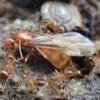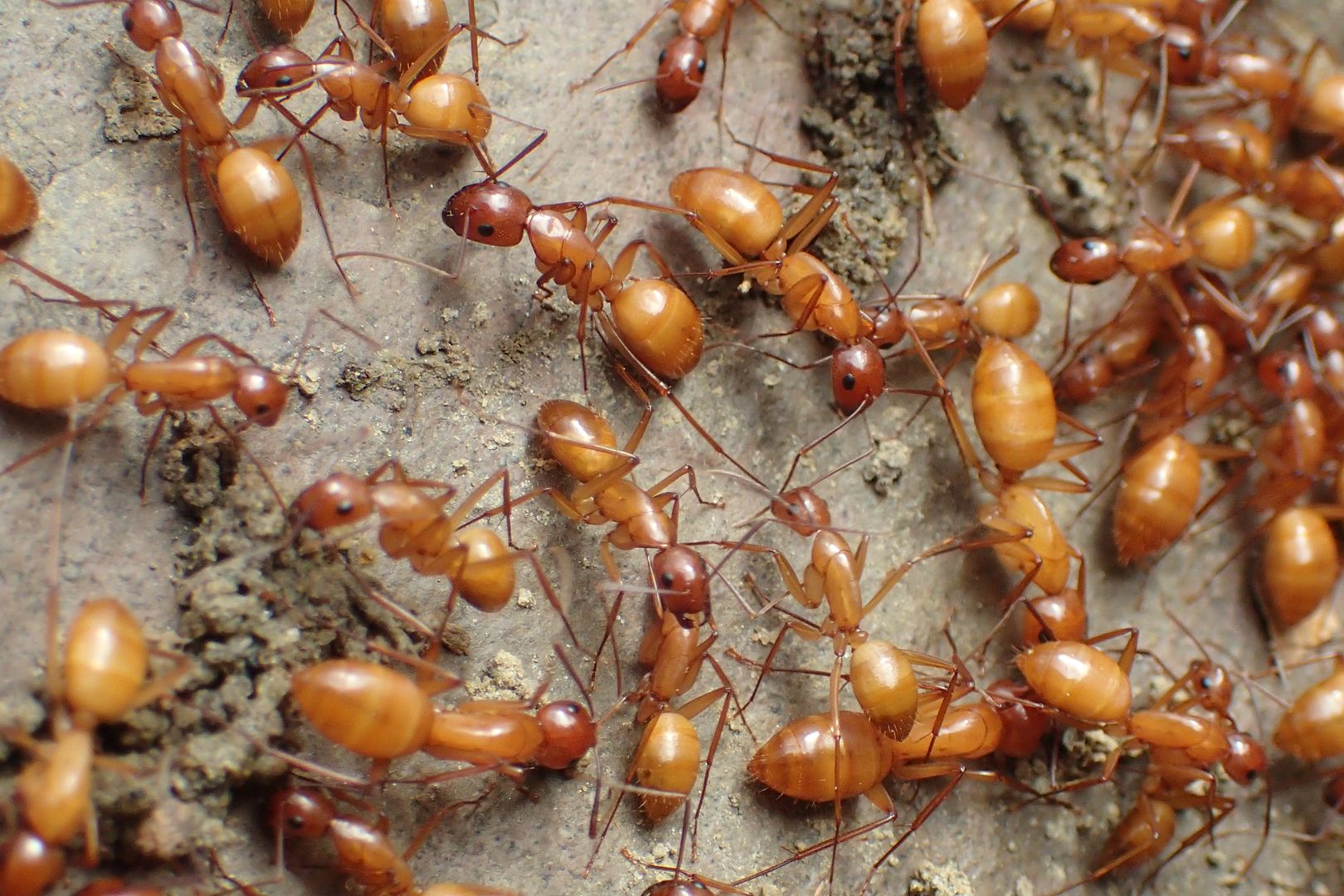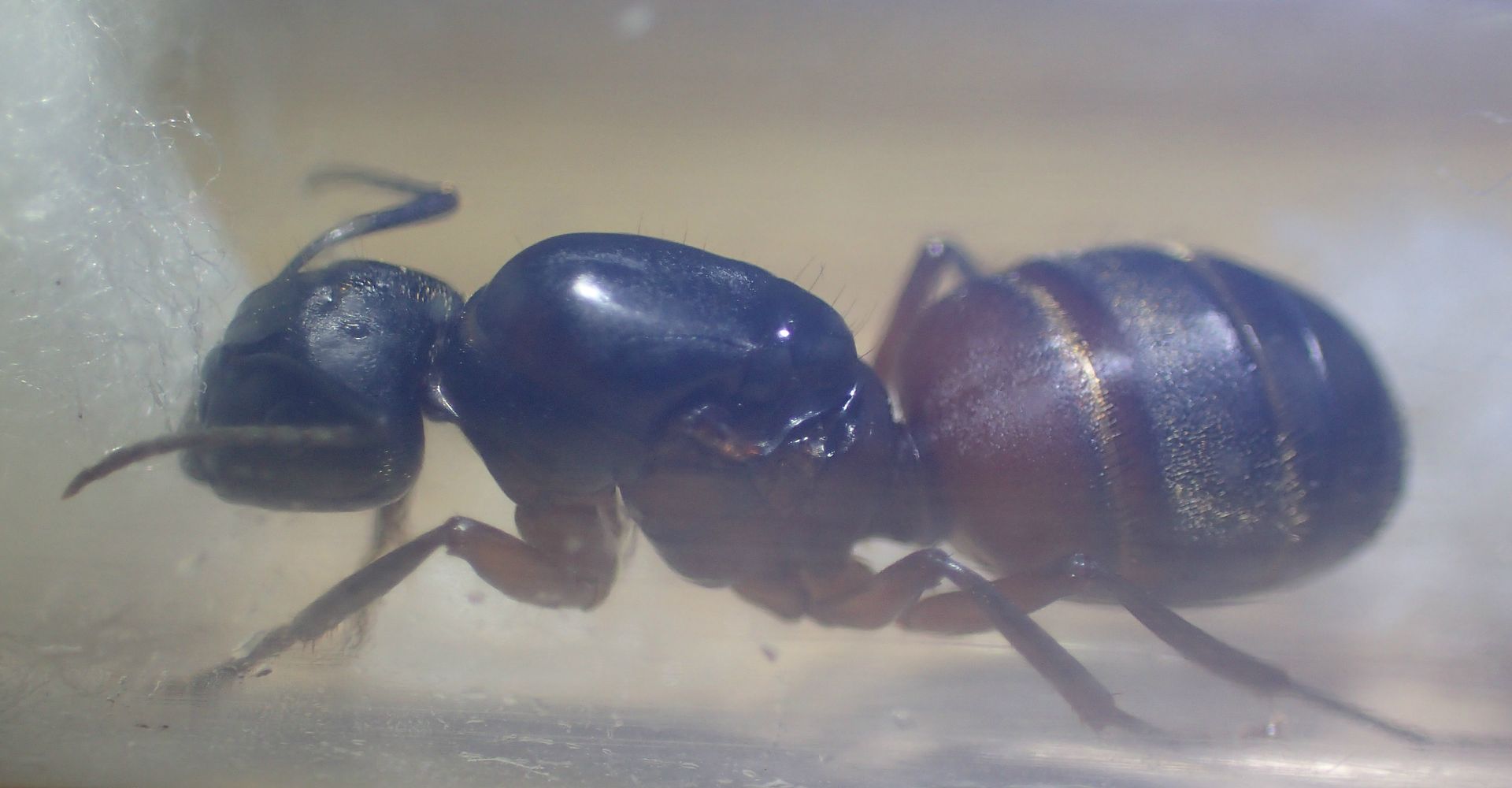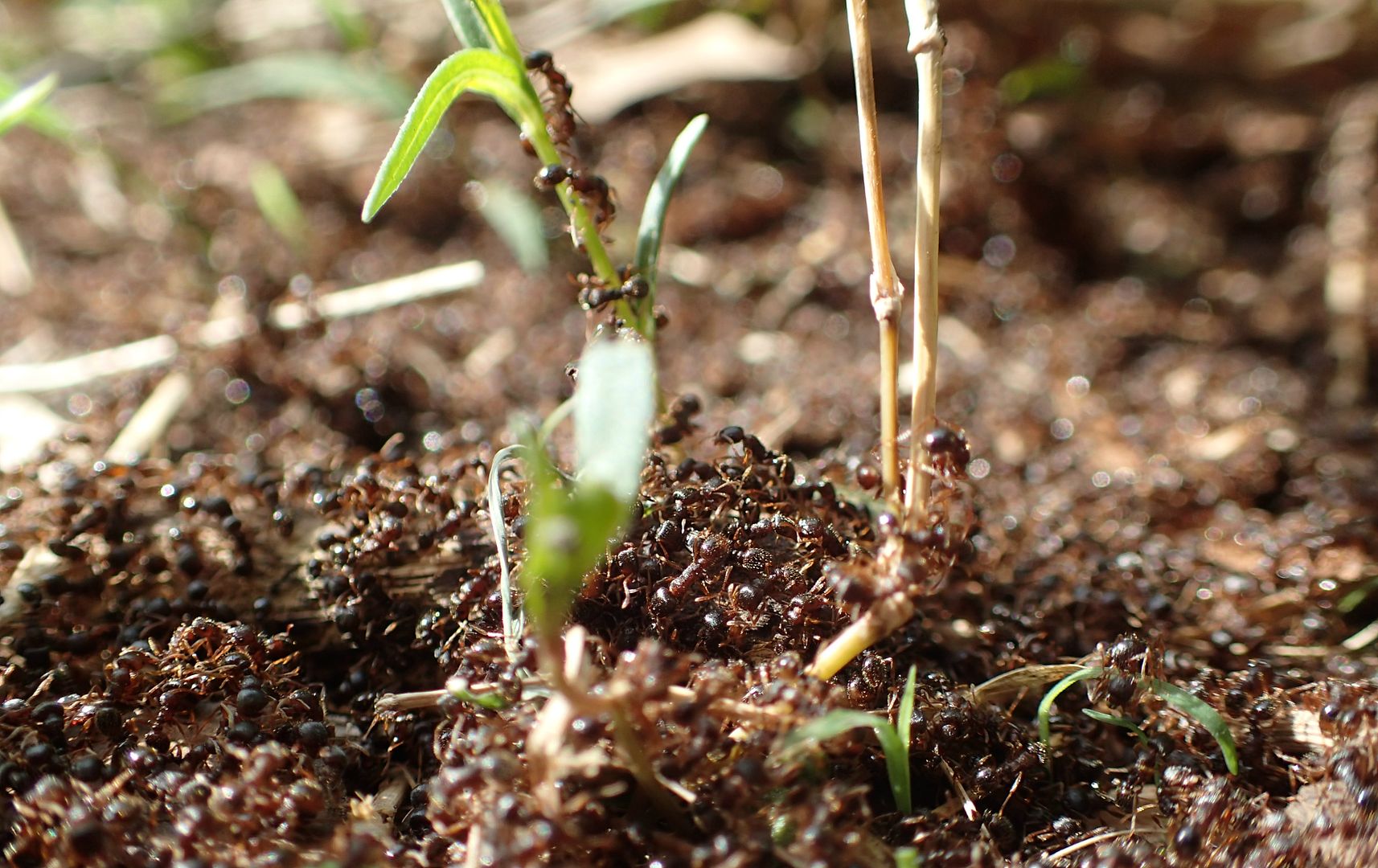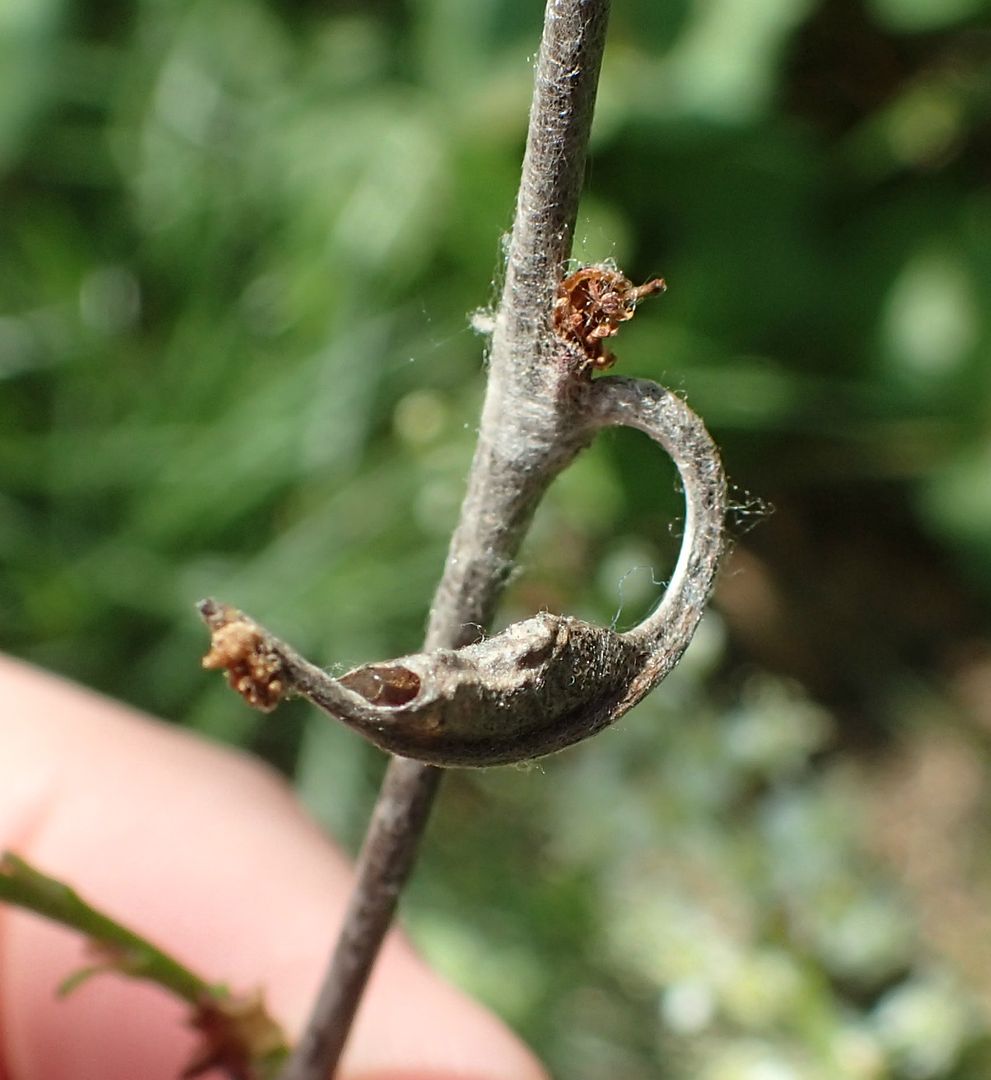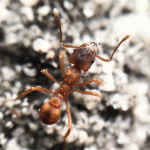This is a work in progress.
Ant Maps is a little generous with what they say occurs here in NJ. I think the number is closer to ~92 species. Of these we have 27 genera across 6 subfamilies. Below is a list with key traits to look for when identifying these subfamilies and then what to look for with each genus and species thereafter.
With most keys that start in the subfamily and work their way down, the waist segments (petiole, and or post-petiole) are where you start. Ants will only ever have either one or two. For ants with two it's usually very obvious as there's more spaces there. These ants are flexible because they have a stinger. Whereas ants that just have one don't have this free space; they're still flexible but not because they have a stinger, rather because they spray formic acid or some other chemical. Ants with one petiole are also better about having repletes (ants that act as food storage) and have a diet more closely associated with carbohydrates (sugars), some are even exclusively tied to the nectar of a certain plant.
Some genera that are known for having a long and slender body-shape have both a petiole and post petiole, however; the post-petiole is connected to the rest of the gaster with a wide surface area. This is because these ants all tend to hunt in rotting leaf litter and tight quarters was important with these ants. You'll rarely find Stigmatomma pallipes hunting outside of leaf litter as they're specialized predators of centipedes. Proceratium are rarely outside of dead wood because they hunt soft bodied arthropods that munch on decomposing logs and leaf litter; they also evolved a gaster with a front facing tip to more easily sting prey. Ponera and Hypoponera nest under stones usually in damp leaf litter but will venture out to the surface, probably making them the most commonly seen genera with this trait, (that being the post-petiole with a wide surface area).
Subfamily Amblyoponinae (Dracula Ants)
Post-Petiole with a wide surface area. They further differ from Ponerinae in having teeth-like structures along the lower margin of the clypeus. Stinger, unclear if painful in humans. They are specialized predators of centipedes. Because of this dietary requirement they're usually found in forests rich in with decades worth of decomposing leaf litter. The centipedes they feed on are predators of the soft bodied arthropods of decomposing the logs and leaf litter. They get the name Dracula Ant from wounding their own larva in non-lethal ways and feeding on the hemolymph (insect blood) for nourishment. This method of adult feeding on the larva is unique to this subfamily, whereas in every other ant subfamily it's common place for the larva to digest food and regurgitate it back to the adult ants mouth to mouth like a normal person via trophallaxis.
Stigmatomma pallipes - Wiki BG
Subfamily Dolichoderinae
One Petiole. These ants tend to be fast moving and spray a variety of chemicals from the tips of their gaster, which lack an acidopore (a tuft of hairs). This is mostly effective on other ants, not so much on humans and larger mammals, though some species let off an odor when crushed. The Odorous House Ant, Tapinoma sessile, is likely the most common species in this subfamily.
Dolichoderus: These are associated with certain types of trees, (Pin Oak?) where they tend aphids, scale insects and mealybugs for nectar. Colonies nest underground adjacent to trees and usually form a small mound of thatch. I've found these at Turkey Swamp Park in Jackson county. Note they all have a "hump" on the rear of the thorax/mesosoma.
Dolichoderus taschenbergi - Wiki BG
Dorymyrmex: All of these ants are top heavy-looking. Their heads are often wider than their gasters and sometimes longer too. All Dorymyrmex have a "cone" too, (a single spine on the back).
Dorymyrmex bureni - Wiki BG Native to the US but not NJ. There is a growing population around the Cape May Light House, and likely that whole county. They're slowly working their way north along the coast with climate change. They nest in sandy soil.
Dorymyrmex grandulus - Wiki BG This species is only found in sandy parts in and around the Pine Barrens as far as I know. They're totally black in color aside from the mandibles. Double check you're not looking at the black form of Forelius pruinosus.
Forelius: Do not have any spines or "cones" and their heads are smaller in size from Dorymyrmex species.
Forelius pruinosus - Wiki BG I have found the black form of this species complex in the white sand areas of the Pine Barrens. Double check you're not looking at Dorymyrmex grandulus.
Tapinoma:
Tapinoma sessile - Wiki BG The Odorous House Ant. This is a very common house hold pest species. They nest in leaf litter, mulch, flower pots, old ants nests especially in winter. The Petiole to this species is almost fused to the rest of the thorax and rarely flexes away. Also I've noticed they consider Solenopsis molesta and likely other Thief Ants to be food, displacing them. It's also interesting to note colonies are smaller and more monogynous in rural areas and more polygynous in urban areas. In some parts of the country it's said they're even forming super colonies in cities, I've not witnessed that here.
Subfamily Formicinae
One Petiole. At the tip of the gaster there is a tuft of hair which is lacking in all Dolichoderinae! That said, this is a trait that requires good magnification to confirm to see most of the time. A lot of times it's just easier to recognize the slightly different shape of the gaster and eye placement on the head. Formicinae species tend to have more variety to their head shape while Dolichoderinae tend to be more aggressive-looking with front facing eyes. This is at least true with the common Dolichoderinae.
Brachymyrmex: These are extremely tiny ants! Queens are also fragile to touch meaning they can be killed simply by handling them improperly. It's best to let them walk into a test tube on their own or else very carefully dab them with something wet and let them crawl off into the container their own.
Brachymyrmex depilis - Wiki BG Superficially this species looks like a very tiny version of a Lasius. Workers are orange/brown in color. Queens are slightly darker brown, though I've found ones that were just as light in color as the workers. Nuptial flights happen in late in the season usually alongside Lasius neoniger in the afternoon hours.
Camponotus: All Camponotus have arched backs, unlike Formica which has two humps. This is a large genus in the US worth separating into further groups.
True Camponotus and Tanaemyrmex Group (These are all large compared to the Myrmentoma group. Workers range from 12 to 18mm long, queens up to 20mm)
Camponotus americanus - Wiki BG Heads are black, rest of body shades of orange/yellow. Queens have more black to them. Nest underground, sometimes mixed in dead wood.
Camponotus castaneus - Wiki BG Orange/yellow all over, head might be darker but never black. Nest underground, rarely mixed in dead wood.
Camponotus chromaiodes - Wiki BG Black head, red thorax, black gaster. Majors ALWAYS have dark shoulders. Hair on gaster just like C. pennsylvanicus. Nest almost always mixed between wood and underground. (C. noveaboranensis Wiki BG might be prescient somewhere in northern NJ. They look similar to C. chromaiodes but majors never have dark shoulders, and the gasters to all castes are not as hairy.)
Camponotus pennsylvanicus - Wiki BG Totally Black with lots of hair on the gaster. Queens sometimes have red/brown legs. Nest only in dead wood.
Camponotus, Myrmentoma Group: These are smaller than true Camponotus and Tanaemyrmex species. Workers range from 8 to 12mm long, queens up to 15mm. Note Camponotus caryae, and C. nearticus for the most part in NJ are totally black in color. Somewhere in the mid-west they "supposedly" hybridize with C. discolor and maybe other species which are bicolored red/black. The red and black forms of C. caryae and C. nearticus are likely found out of state.
Camponotus caryae - Wiki BG Lots of facial hair, totally black for the most part... some populations might have shades of brown/red to them. Color is not that reliable here.
Camponotus nearcticus - Wiki BG Almost no facial hair, or hair at all, Totally black for the most part... some populations might have shades of brown/red. Color is not that reliable here.
Camponotus subbarbatus - Wiki BG Not totally black. Often with shades of brown or lighter in the joints. Majors and Queens especially have very noticeable yellow bands around the gaster! This is not an effect seen in repletes and queens where the membrane is showing; the plates of the gaster itself are actually this color. This trait is not as easily seen in minor workers, they still have the bands but almost have to be swollen with food (a replete) in order to see the yellow part, and yes the membrane is showing, thus they're semi-transparent.
Colobopsis: (Door Ants) These all used to be Camponotus but were promoted to be their own genus. The heads to queens and majors are flat in the front to form a "door" to block entrance ways. These might be restricted to nesting in certain types of wood or having a limited diet (in the wild) thus they may only be found where certain tree species occur. Queens fly at night over the summer months.
Colobopsis mississippiensis - Wiki BG
Formica: This is the most diverse genus in the US with roughly 100 species. Because of this it's worth breaking them up into smaller groups.
Formica (exsecta) exsectoides - Wiki BG Visit Turkey Swamp Park in Jackson County. They make huge mounds and form super colonies. Spray formic acid.
Formica Fusca Group: in NJ are all totally black and have large eyes compared to their head. They also all have a lot of "pubescence" (a fine sheen of very tiny hairs) all over the body. They're also a little hard to tell apart. I honestly don't know how the true F. fusca species differs from F. subsericea. F. argentea should be easy enough to google the difference.
Formica (fusca) argentea - Wiki BG
Formica (fusca) fusca - Wiki BG
Formica (fusca) subsericea - Wiki BG
Formica Pallidefulva Group: Workers in this group have the narrowest head width of all the other Formica. They're either a brass color or bicolored dark brown and black. NJ falls in a transition zone where both species have different color forms. I have never seen a mixed nest of these so it's one color or the other.
Formica (pallidefulva) incerta - Wiki BG Workers have a few hairs on the face and along the dorsum of the mesosoma/thorax which are lacking in F. pallidefulva.
Formica (pallidefulva) pallidefulva - Wiki BG Workers are not as hairy as F. incerta, though neither species is particularly hairy to begin with.
Formica Neogagates Group: Size-wise this group has the smallest species. F. neogagtes is about the same size as Lasius neoniger.
Formica (neogagates) neogagates - Wiki BG
Formica Microgyna and Rufa Groups: These are all parasitic species that use members of the pallidefulva and fusca groups to sustain their colonies. For the microgyna and rufa species host workers are only required for colony founding. Further raids on host colonies might occur but are not required to sustain the colony. Note the "microgyna" group all have worker-like queens that barely stand out from the regular worker. A set of wing scars and maybe a slightly different color is all you get.
Formica (microgyna) difficilis - Wiki BG
Formica (microgyna) querquetulana - Wiki BG
Formica (rufa) integra - Wiki BG this species is gigantic compared to other Formica. Some of the workers are as large as Camponotus chromaiodes majors. They establish trunk trails from their nests to plants where they tend aphids. There is a population at Turkey Swamp Park, in Jackson County, along the lake there.
Formica (rufa) obscuriventris - Wiki BG
Formica Sanguinae Group: These are all parasitic species that use members of the pallidefulva and fusca group to sustain their colonies. For sanguinae species host workers are essential to the long term life of the colony. Workers are completely incapable of even caring for their own brood and feeding themselves. Colonies conduct raids on host colonies as needed and usually move every day or two into a new host colony. All of the host colony reproductives are killed or driven out of the colony in the process. (If they weren't so parasitic on their host species they could almost be considered army ants.)
Formica (sanguinae) pergandei - Wiki BG
Formica (sanguinae) rubicunda - Wiki BG
maybe Formica (sanguinae) subintegra - Wiki BG
Lasius: This genus is also common in Europe with many of our North American species sharing the same names. There is evidence to suggest the North American species are different species entirely though. Lasius flavus builds large domed mounds in Europe but not in America. In the book "A Field Guide to the Ants of New England" several unidentified species were discovered as well. It's more than likely most of the North American ones will be given new species names someday but this is pending a review of the genus.
Lasius Niger Group: Workers are dark in color, either dark brown or black. Hairs on the legs and body help distinguish them. Queens are fat and usually fly around August/September and have no problem starting colonies on their own. (Also note niger is pronounced nyjer.)
Lasius americanus (formerly alienus) - Wiki BG Nest in wood or mixed in dirt, forests/around trees. Ant Web (and Ant Wiki) both have an odd photo of a queen that has a parasitic body structure. I'm not sure what the story with that one is but more frequently queens of this species are robust-looking as with other species in this group. The Yellow legged form might actually be Lasius crypticus Wiki, BG, which would explain an odd dark queen mixed in with the other Lasius that fly in August, September
Lasius neoniger - Wiki BG Nest in sandy soil, full sun, fields.
Lasius pallitarsis - Wiki BG Also nest in sandy soil, full sun, fields. They differ from the other two in having an additional tooth in the mandibles (which the species name is referencing.) This is another one of those traits that requires a really good microscope to observe. Workers are a unique in-between color, not quite orange, and not quite dark brown. Queens are another story, looking very similar to L. neoniger; they might differ in having a yellow underside to the gaster but this hasn't been confirmed.
Lasius Flavus Group: Workers are orange in color. Queens are slightly smaller than those in the niger group.
Lasius brevicornis (formerly flavus) - Wiki BG
Lasius nearcticus - Wiki BG, Ant Wiki might have the wrong photo for a queen. They sure look different than what Alex Wild has photographed and James Trager identifies as them on Bug Guide, both people are clear authorities in all things Ants in North America. If this species does have two forms for the queen then it's likely the shorter parasitic-looking one requires additional food or is only found in colonies that tolerate more than one queen and colonies may divide from there. It's unclear which is the case. Workers are slightly polymorphic in eastern U.S. but not in western.
Lasius Umbratus Group: Workers are orange. Queens are social parasites and must replace the queens of members of the niger group to reproduce.
Lasius minutus - Wiki WebSite Rarely found. These nest in bogs and form large mounds. The species name refers to the queens being described as small; I don't believe they've ever been photographed.
Lasius speculiventris - Wiki BG Rarer still! These are said to use Lasius minutus as a host species. (They're a social parasite of another social parasite.)
Lasius aphidicola (formerly umbratus) - Wiki BG Queens tend to be black and fly sometime in early spring. Workers have a dingy sheen of hairs to them. I've found them nesting in dry wood.
Lasius Claviger Group: Workers are orange, and usually give off a slight citronella odor when disturbed. Queens are social parasites and must replace the queens of members of the niger group. Adult colonies go on to become subterranean aphid farmers, usually nest among the roots of trees and shrubs.
Lasius claviger - Wiki BG Queens are a brown color, though I've witnessed red individuals leaving colonies too seemingly 1 in every 100 queens. Flights happen in late autumn, usually after L. neoniger is done.
Lasius interjectus - Wiki BG Queens are red/orange in color and fly in the spring. Interestingly enough they have been seen using Lasius claviger as a host.
Lasius latipes - Wiki BG Queens are huge red lumbering tanks! Their legs are thick and wasp-like! They fly over the summer and barge right through the walls of host colonies looking to decapitate the host's queen! After murdering her she'll then roll around in her bodily fluids (gaining the colony odor) and take over the roll as egg layer. Strong host colonies over power them with numbers while weaker ones fall. They're listed as a threatened species on And Wiki but I'm not sure what this is based on.
Lasius murphyi - Wiki BG Queens are very similar to L. latipes but with slightly slimmer legs. Most noticeably though queens have a patch of yellow hairs on the face. (If they weren't murdering parasites I'd call this the Hercule Poirot Ant.) Fly in summer and have the same method of infiltration.
Lasius subglaber - Wiki Ant Web Queens are very similar to L. claviger but fly over the summer time. Hairs differ on the body between these two species.
*There is also a species that flies over the summer with bicolored queens (head and thorax are orange/brown, the gaster is black). I've not been able to confirm what this is but it might be a form of L. interjectus.
Nylanderia: This is a genus of tramp species. They travel the world over thanks to human commerce and are at home in the leaf litter in woodlands. Both species seem to over winter their queens as Camponotus and Prenolepis do so they may engage in early season nuptial flights.
Nylanderia faisonensis - Wiki BG Workers are a uniformly brown color, or sometimes with a lighter colored thorax/mesosoma.
Nylanderia flavipes - Wiki BG Workers are uniquely bicolored with the gaster being two colors.
Polyergus: This is a specialized slave maker of Formica species. Our native population uses colonies of Formica incerta (though not F. pallidefulva?) I have found these at Rancocas before but the population seems to move around.
Polyergus lucidus - Wiki BG (They're a brilliant red color with large tusk-like mandibles. These are not used for war as one might think, rather they're idea for snatching brood of the F. incerta colonies they raid. F. incerta are fairly timid when assaulted. Polyergus mostly run past the workers, snatch the brood up and are gone. Because of this colonies of F. incerta may close up their nest entrances at certain times of day in reaction to this.
Prenolepis: This is a genus with a single species in it throughout most of North America. It's somewhat diverse in size and color too. In NJ I've seen them range from black, hues of brown, to a pail blond color, as well as bicolored forms. The pail variety seem to only nest in sand. The black variety seems notorious for long foraging lines leading up oak trees likely to tend scale insects. Queens are normally beautify colored too and worth googling. The common color form (dark head, rose thorax/mesosoma, and the blond gaster) comes in at least two sizes and it's unclear if this is a different variety or a dietary issue within a single colony. I've also seen queens that match the pail blond coloration of the pail blond variety but she was the only queen of that colony with that color form; the workers of this colony were not of the pail variety as one might expect. Workers also balloon up like with sugars and have repletes like honey pot ants. These sugars are converted into a fat body though hence the other common name, false-honey ant. (In the mountains of California there's a version of this species with totally black queen.)
Prenolepis imparis - Wiki BG They are called the Winter Ant because of their ability to forage in colder temperatures than any other ant in the US and Canada. They even hold nuptial flights on the earliest warm days of the year, a good month before Camponotus and Nylanderia which also over winter their queens.
Subfamily Myrmicinae
Two Waist Segments! This is also the most common subfamily in North America (the world?). A lot of these tend to like heat, are associated with seeds, one even grows fungus.
Aphaenogaster: These species are at home in woodlands and along forest edges. A. fulva and A. rudis are both considered species complexes, meaning both are comprised of multiple species that are almost identical to one another. They require a DNA test to count the number of chromosomes they have. Generally it's best to leave it at A. fulva or A. rudis and not care about the specifics. You may notice some colonies of one has several queens in it while others only have one and other slight differences too.
Aphaenogaster fulva - Wiki BG Woodland species, tends to hue more orange/brown.
Aphaenogaster lamellidens - Wiki BG Much larger than A. fulva or A. rudis. They are Formica-like in size. Could only be confused with A. treatae but they have a smooth antenna scape. (Also Note Ant Wiki has the WRONG PHOTO for this species that shows them very clearly with flat antenna! This is actually A. treatae! Ant Wiki also has the correct photos from ant web on the same page.)
Aphaenogaster rudis - Wiki BG Woodland species, tends to hue more dark brown/red. (Aphaenogaster carolinensis Wiki BG has also been reported in NJ but is identical-looking to A. rudis aside from slightly smaller spines and having different DNA.)
Aphaenogaster tennesseensis - Wiki BG Bright red/brown color. Colonies are often very large compared to other species. Queens are social parasites of A. fulva, and A. rudis colonies. Queens are also about the same size as the workers and use an interesting method to take over a colony. They gain the colony odor by interacting with dead worker or scouts they encounter. After a time they simply enter the nest and hang out seeming to do nothing in particular. Eventually the host workers turn on their mother, eventually killing her.
Aphaenogaster treatae - Wiki MI Large like A. lamellidens but uniquely the antenna scape close to the head is flat and paddle-shaped
Crematogaster: This genus is unique because the post-petiole attaches to the upper half of the gaster. Every other ant genus in the world attaches to the lower! This allows Crematogaster to arch their gaster forward like a scorpion would. They're given the common name Acrobat Ants. The gaster to both species is heart-shaped. Both make super huge colonies with foraging lines connecting several satellite nests, always in dead wood structures. They sometimes build "sheds" around aphids they tend on plants. The number of hairs on the thorax/mesosoma is how the two species are told apart.
Crematogaster cerasi - Wiki BG
Crematogaster lineolata - Wiki BG
Monomorium: These are very tiny black ants. They look sort of like Tetramorium (pavement ants) but are much smaller and very shiny. They also only nest in sand, though sometimes the leveling material used under bricks and hard-scapes will work too. Both species look similar and differ in the number of hairs on the body. I have found colonies which have dozens of queens in them that seem to either inbreed or divide over the year. And on other occasions I've found lone queens venturing out on their own to start their own colonies. I'm not sure which was which or if it's population based.
Monomorium emarginatum - Wiki BG
Myrmecina: These are easy to confuse with Tetramorium immigrans workers and Temnothorax longispinosus. Myrmecina americana has more strongly clubbed antenna though and the waist segments are proportioned differently along with slight differences to the erect hairs and texture of the body. This is a woodland species that nests in soil and under the bark of trees adjacent to the soil. They're specialized predators of mites and likely other soft bodied arthropods. Queens are very worker-like in size and appearance, also workers are slightly bulky and slow moving. Personally I've never located a colony of these but their fairly common in the pine barrens.
Myrmica: Very similar to Aphaenogaster in appearance but with shorter legs and more texture to the body. These tends to be found in fields and what might be described as "scrub land" where odd sorts of plants seem to grow. I don't encounter these enough to know how to tell them apart, google it or post an ID thread. If you're in NJ you have a 1 in 3 chance of being right.
Myrmica punctiventris - Wiki BG
Pheidole: Big-headed Ants. Fly over the summer usually at night or late afternoon. All species seem to nest in sandy soil. Not so lush lawns are often a goldmine of colonies. Lasius neoniger is often present too.
Pheidole dentata - Wiki SoA (dubious)
Pheidole dentigula - Wiki (dubious)
Pheidole pilifera Wiki BG (I think this one has the largest majors if that helps)
Solenopsis: (Thief Ants) NJ lacks any fire ants, but their cousins the thief ants are here in mass. S. molesta is the most common in suburban settings. S. texana seems restricted to patches of almost pure sand, meaning almost no loam or clay mixed in.
Solenopsis carolinensis - Wiki MO Said to be a smaller version of S. molesta but I've never found it in person. Supposed to be more common in "the south" likely replacing S. molesta down there so they might be uncommon in NJ. Queens have a larger eye in comparison to the head to S. molesta queens.
Solenopsis molesta - Wiki BG Queens are uniquely colored with the head a darker shade of orange/brown than the thorax/mesosoma, and the gaster lighter still. Some get infected with a parasitic fungus that turns the gaster black but these are infertile.
Solenopsis texana - Wiki BG Queens lack the darker head of S. molesta and are lighter in general, more yellow. Ant Maps doesn't report this species in NJ but I believe I've encountered this species at a sandy patch in Rancocas but am not completely sure.
Stenamma: Probably the easiest ant to confuse with a Temnothorax. The eye placement on the head is different though. I've never located a colony of these but have found queens in late spring unlike most Temnothorax that do so in the summer. Queens and males over winter within the nest. Colonies likely form under ground or in dead wood adjacent to the soil. Colonies are small ranging from ~12 to ~200 workers.
Stenamma brevicorne - Wiki BG YT one of the most wide spread species of Stenamma in the US and Canada. Again never found a colony of these but I chance upon stray queens in spring (and once in late autumn which was likely a colony low on food casting out queens they couldn't support over the winter). Colonies nest underground and are usually bustling with worker activity.
Strumigenys: Specialized predators of soft bodied arthropods. You'll only ever find these foraging in "cold" situations even in summer. They nest in decaying logs rich with the creatures they feed on. They're covered in petal-like structures (modified hairs) which help mask their scent and make hunting easier. Nuptial flights are in August, but only on cloudy days with heavy over cast, sometimes even in a light drizzle. I've found swarms of queens to these all over cars in parking lots. (It's also a good time to go car shopping.) Along with having different body texture the pattern of petals on the head in face view are fairly unique to each of the three. Note the act of looking for colonies of these often destroys the log in the process. Though rarely found, these ants are likely very common even in suburban settings. Colonies probably move frequently deeper into the soil when needed and only venture to the surface when conditions allow. Colonies are very tiny also and fit neatly into small enclosures. Despite just the 3 species in NJ, this genus is surprisingly large and diverse throughout the US! It wouldn't surprise me to learn more are in NJ that have been overlooked.
Strumigenys ohioensis - Wiki BG Has the most texture on the body.
Strumigenys pergandei - Wiki BG Body texture is somewhere in the middle.
Strumigenys pulchella - Wiki MO Has the least texture on the body.
Temnothorax: (Acorn Ants) While they do indeed nest in hollow acorns, really they'll nest in any kind of dead plant matter. They're looking for an open cavity with a small defendable nest entrance.
Temnothorax ambiguus - Wiki BG (brown/orange with not as curved spines compared to T. curvispinosus.)
Temnothorax curvispinosus - Wiki BG (brown/orange with curved spines)
Temnothorax longispinosus - Wiki BG (black and with long spines)
Temnothorax schaumii - Wiki BG (also brown/orange but spines are very short)
Tetramorium: (Pavement Ant) and parasite.
Tetramorium immigrans - Wiki BG (formerly Species E... formerly caespitum) This is an invasive species that has displaces Formica and Lasius to some degree. For the most part though they've naturalized and focus more on territorial disputes between other colonies of pavement ants. Finding two colonies going at it is fairly common. This is a sun loving species that takes advantage of rocks and logs so they can incubate their brood to develop faster. Colonies in ideal locations begin sending out queens in the last week of May, whereas others in less ideal locations start flying later in the month of June, and sporadically in July and occasionally August. Flights happen late at night (midnight or after!) and queens are very commonly found floating in swimming pools the day after.
Tetramorium atratulus - Wiki BG (formerly Anergates atratulus though not all the websites seem to have updated.) This is an inquilin parasite of queenless T. immigrans colonies. Queens of these can also be found in pools over the summer but are so odd looking they superficially resemble the males of other species. The males of this species are only found within infected host colonies, and superficially look like they should be the queen from their body structure.
Trachymyrmex: (Northern Fungus-Farming Ant) This is uniquely the only fungus growing species that makes it this far north. In NJ, sandy soil, full sun, and an abundance of caterpillar and herbivore insect frass are essential for this species. White Oak Trees, Quercus alba, growing in a forest edge on a sandy field is usually a good sign. In NJ they're abundant in Jackson County and likely along the coast northward. They've been seen at Rancocas too but I've never been able to locate them. This is a very unique-looking ant impossible to mistake for anything else.
Trachymyrmex septentrionalis - Wiki BG (Queens fly around the second week of August in the afternoon)
Subfamily Ponerinae
Two Waist Segments, Post-Petiole connects to gaster with a wide surface area. (Telling these two species apart can be difficult as they look very similar. In side view there is a difficult to see spine under the petiole found only in Ponera and NOT in Hypoponera. Also "I believe but could be wrong that, Ponera tends to be more of a leaf litter hunting species that rarely comes out to forage in the open. I think Hypoponera is the one that ventures out more openly to hunt on the surface. I could have these backwards though.")
Ponera pennsylvanica - Wiki BG
Subfamily Proceratiinae
Arguably Two Waist Segments, Post-Petiole connects to gaster with a wide surface area. Gaster is front facing. I can't stress this enough; the ants isn't bending their gaster to curve forward. The hard plates of the of the exoskeleton is naturally set in this position to always be facing this way. This is unique to all species in this subfamily but they do vary to different degrees.They nest in the same conditions as Strumigenys species, damp, decaying wood, teaming with soft bodied arthropods for them to hunt. They've also been found nesting under patches of moss and have a specialist diet of spider eggs.
Proceratium crassicorne - Wiki BG very similar-looking to P. silaceum but sculpture on face is less impressed (shallower). Colorwise they're a more consistant orange with less variation.
Proceratium pergandei - Wiki BG easily identified by the front facing gaster protruding far out underneath. Slimmer than the other two species and with slightly shorter hairs.
Proceratium silaceum - Wiki BG probably the most common of the three species in NJ, very similar to P. ccrassicorne but sculpture on face and body is deeper overall. Colorwise they're more varied with darker patches of color on the body.
Edited by MrILoveTheAnts, August 25 2021 - 12:02 PM.


